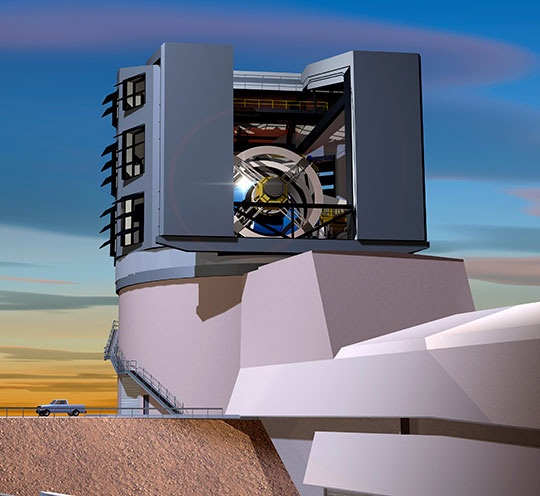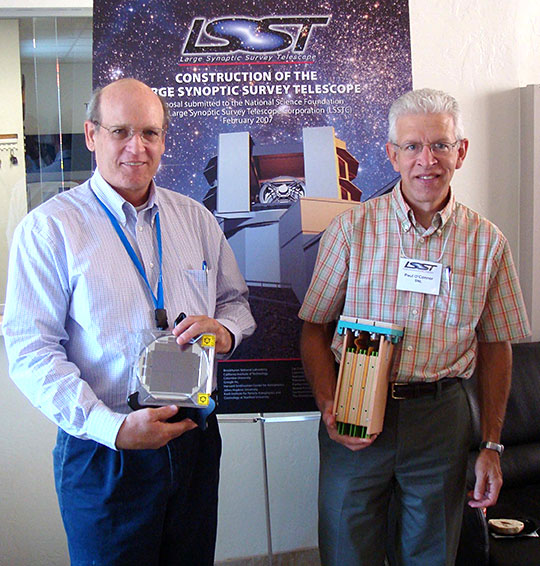Digital Sensor Array
Institutions all over the world have contributed to the facility assembly and experimental operation of the Rubin Observatory Legacy Survey of Space and Time (LSST), and Brookhaven Lab designed and constructed one of the most critical components: the digital sensor array. After all, what is a camera without film?
Photographing five billion galaxies spinning in the farthest reaches of space demands powerful, ultra-sensitive, and utterly unique digital “film.” The same technology used in consumer digital cameras, sensors that convert visible light into electric signals, has been expanded and enhanced to capture near-ultraviolet and infrared light as well.
Developing these sensors, which provide more than three gigapixels of
resolution, was a unique challenge and opportunity for Brookhaven's
Instrumentation and Super Conducting Magnet Divisions, as well as the
Physics Department.
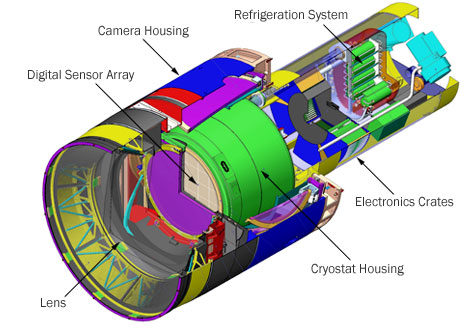
Mosaic Building
The LSST team at Brookhaven experimented with an entirely new generation of charge-coupled devices (CCDs) featuring greater sensitivity, better resolution, and faster readout time than those used in other astronomical cameras.
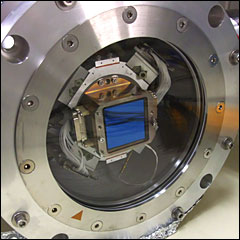
Prototype charge-coupled device (CCD).
CCDs are light-sensitive electronic circuits that capture an image in such a way that each pixel on the device converts light from the subject into an electrical charge that represents a specific detail. The higher the pixel count, the greater the range of colors and details that can be uniquely converted into digital information, which in turn can be interpreted by a computer. With 3.2 gigapixels built into supersensitive CCDs aimed at the night sky, very little can escape the vision of the LSST camera.
The key to achieving the wide range and massive images that make LSST so unique is modularity, which guides the design and assembly process. The LSST camera is a mosaic camera, so called because it will use 201 separate custom-built sensors operating simultaneously to stitch together a complete image—similar to the way light strikes the distinct tiles within a mosaic. While each of the contact points, or tiles on the mosaic, can be viewed individually, it is only when taken as a whole that the complete picture can be seen. All the sensor tiles of the LSST camera must act in flawless, precise concert.
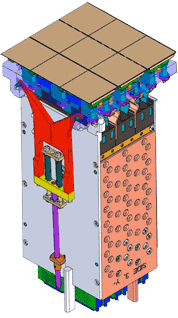
3x3 CCD module with integral electronics. LSST's focal plane will contain 189 CCD imagers.
The entire camera array will contain 189 CCD sensors to collect the scientific images, and an additional 12 CCD sensors dedicated to guiding and focusing the camera. Each of these square sensors, made from specially grown silicon crystals, is roughly 1.5 inches across. These, in turn, are combined into what the team calls submosaics, flat "rafts" of nine sensors arranged on a three-by-three grid.
The assembly is painstaking, allowing for no more than 250 microns (millionths of a meter) between CCDs, in order to catch nearly every photon arriving from deep space. The team completed 21 of these rafts, each of them effectively operating as an independent digital camera. This modular design allows for thorough testing as the technology develops, and also easier repairs should the need arise in the future.
Any speck of dust can distort and damage the LSST images. The scientists working to build the sensors in the Instrumentation Department work in cleanrooms, wearing full-body suits and masks to keep the CCD surfaces pristine. Any slight tilt along the submosaic array can also spoil the image, so the CCDs must lie almost perfectly flat, with no more than a 10-micron [ten millionths of a meter] tilt in any direction.
Custom Electronics
Most astronomical cameras require up to several minutes to read out an entire image, but the LSST camera will need only two seconds—that's about two orders of magnitude faster. This breakthrough speed comes from the massive modularization of the camera, in combination with custom-designed electronics behind every sensor that is splitting the information into thousands of discrete bits.
The signal from each CCD sensor is divided into 16 read-out segments that can be independently processed in parallel. On each of the modular rafts, the nine sensors provide 144 read-out points of dense photography; the entire imaging surface will produce more than 3,000 channels of data.
When operating, the camera will convert the various forms of light captured by the telescope into digital data at a rate of about 11 trillion bits per hour. To form the complete camera, the Brookhaven-designed-and-built sensor units are integrated with components built by collaborating institutions—lenses, filters, and systems for keeping all these high-tech electronics cool.




